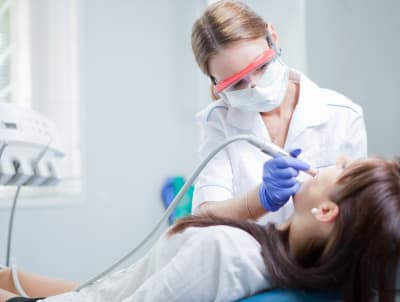Many want a stable, fulfilling career with an impressive salary and great prestige. The healthcare field checks all of these masks, so it is common to find people contemplating a career in healthcare during specific points of their life.
Two of the more popular careers in healthcare are dental assisting and dental hygiene, both in high demand and offering a direct path to becoming licensed and practicing as fast as possible.
Both careers also share a great deal of similarities, and it can be confusing to choose between them.
We have you covered for those who would like to consider a career in either of these two and would like to know the differences between them. Continue reading to find out everything you need to know about both occupations.
Dental Hygienist vs. Dental Assistant - Who are they?
While they share some similarities in function, one of the first ways to tell a dental hygienist from a dental assistant is in the scope of what they do.
Who is a Dental Hygienist?
Dental hygienists are healthcare professionals who help patients maintain optimal oral health and dental hygiene. They do this through various specific duties, including performing dental screening, taking and developing x-rays, and ensuring the patient is well-prepared for their procedures.
They also help dentists during procedures by preparing the treatment room and ensuring patients are comfortable and anesthetized.
Who is a Dental Assistant?
Just like dental hygienists, dental assistants help patients achieve sound oral health by providing crucial help to a dental team. Unlike dental hygienists, however, a dental assistant’s exact duties are limited.
Generally, though, dental assistants help take care of patients and keep records. They can’t, however, perform certain functions such as applying fluoride, sealants, and other cavity prevention treatments - tasks that dental hygienists are qualified to perform.
It should be mentioned, however, that certain states allow dental assistants to carry out some of these advanced tasks.
Differences in Responsibilities
Dental Assistants
Dental assistants play a critical support role in a dental team. Below are some of the primary responsibilities of a dental assistant.
- Make sure patients are comfortable enough in their chairs
- Make certain patients are prepared and have enough knowledge of their upcoming treatment and procedure
- Help sterilize dental instruments and hand them over to the dentist at appropriate times during the treatment/procedure
- Dry patient’s mouths using the proper equipment
- Keep records of treatments
- Help schedule appointments
- Take care of billing and payment
Dental Hygienists
Just like dental assistants, dental hygienists can help prepare patients for procedures, educate them on what they need to know, and help them feel comfortable in the chair.
Dental hygienists are also qualified to take on a higher level of responsibility and perform more technical tasks than dental assistants.
Below are some of the primary responsibilities of a dental hygienist.
- Remove plaque, tartar, and stains
- Apply sealants and fluorides to protect the teeth
- Take and develop X-rays to discover possible problems before they arise
- Examine a patient’s medical history and report essential details to the dentist
- Record treatment plans
- Teach patients about proper dental hygiene
Educational Differences
Dental Hygienists
Educational requirements vary for dental assistants and dental hygienists. Dental hygienists must usually have an associate degree before they can practice. They may also choose to pursue a bachelor’s or master’s degree.
Dental hygiene programs are available in vocational schools, community colleges, and universities.
Dental Assistant
Unlike dental hygiene, it is common to begin dental assisting without formal education - although some states don’t allow this. Apart from on-the-job training, it is possible to become a dental assistant by graduating from an accredited program.
These programs are available in vocational schools and colleges. They can be completed in a year or less.
Differences in the Work Environment
Dental Hygienists
The U.S. Bureau of Labor Statistics revealed about 226,400 dental hygienists in the country as of 2019. Most of these (about 93%) worked in dentists’ offices, while the remaining were spread between offices of physicians and government institutions.
Working part-time or full-time as a dental hygienist is possible, but most work part-time.
Dental Assistant
Just like dental hygienists, dental assistants are found primarily in dentists’ offices, followed by physicians’ offices and government establishments. As of 2019, there were 354,600 dental assistants in the country.
It is also possible for a dental assistant to work part-time or full-time, but most choose to work full-time.
Differences in Salary
Dental Hygienists
Dental hygienists earn an average salary of $76,000 yearly, with the top ten percent of earners taking home about $103,000. Alaska and California are the two highest-paying states for dental hygienists.
Dental hygienists earn more than dental assistants on average.
Dental Assistant
Dental assistants earn an average salary of $40,000 annually, with the top ten percent earning about $56,000. Minnesota and Alaska are the two highest-paying states for dental assistants. They earn less than dental hygienists on average.
Differences in Job Outlook
Dental Hygienists
According to the Bureau of Labor Statistics, there will be a nine percent growth in the employment rate of dental hygienists between 2021 to 2031. This rate is faster than the national average.
The Bureau projects 16,300 new job openings every year within the period. This figure is attributed to the need to replace aging workers and those moving to a different occupation.
Dental Assistant
The Bureau of Labor Statistics projects an eighth percent growth for the dental hygiene field between 2021 to 2031. This is significantly higher than the national average.
The Bureau calculates that there will be about 56,400 openings for dental assistants annually within this period. Like dental hygiene, the growth of dental assisting is attributed to the need to replace aging workers and those moving to new professions.
It also credits ongoing research in dentistry and people taking their oral health more seriously.





